
Root canal therapy is a non-invasive and painless method that can save teeth in dogs. It has a success rate of around 96% and requires less recovery time compared to extractions(1).
The term “root canal” is a colloquialism for endodontic therapy. For the purposes of this article, the term “root canal therapy” will be used in lieu of the term endodontic therapy.
The Anatomy of Dog Teeth
The anatomy of a tooth includes enamel, dentin, and the root, which houses the pulp containing blood vessels and nerves. The crown is the portion of the tooth above the gum line. It is covered by enamel, an incredibly hard substance in the body although it is brittle and prone to fracture. The tissue under the enamel is dentin, which in dogs, becomes thicker with age.
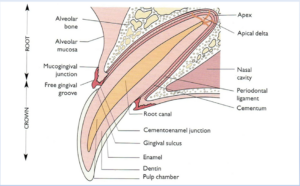
The image to the right is a fairly busy diagram of a cross-section of a tooth.
Interestingly a dog’s enamel is on average 1/10th the thickness of human enamel. It is theorized that thin enamel will allow the tooth to bend a bit—a bit of bend is necessary because the mouth is the dog’s hands, and the teeth are their fingers. Thick enamel would be more prone to fracture.

It is important to note the thickness of the dentinal wall because young teeth may be more difficult to perform root canal therapy on.
The next layer and under the dentin is the hollow area called the root canal. The root canal houses the pulp. The pulp contains the blood vessels and nerves that supply the tooth with nutrients and sensation. The nerves contained within the pulp are very efficient at conducting pain.
When is a Root Canal Necessary?
One may ask what issues may cause the need for root canal therapy. Fractured or non-vital (dead) teeth are the most common reasons for needing root canal therapy. Teeth fractures expose the pulp can cause extreme pain and lead to abscesses.
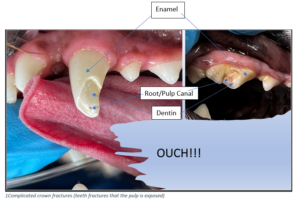 We know that dogs feel the same sensations as people, therefore, imagine how you would feel if the pulp of your tooth was exposed by a fracture—that’s exactly how your furry companion feels. And unlike humans, dogs mask a high degree of pain due to their survival instincts.
We know that dogs feel the same sensations as people, therefore, imagine how you would feel if the pulp of your tooth was exposed by a fracture—that’s exactly how your furry companion feels. And unlike humans, dogs mask a high degree of pain due to their survival instincts.
Teeth with fractures exposing pulp always die. After the pulp dies the pain is greatly diminished, however in time the pulp rots, often leading to painful abscesses.
When a dog has a tooth fracture exposing the pulp, a complicated crown fracture, or a non-vital tooth there are only three treatment options:
- Do nothing
- Extraction
- Root canal therapy.
Doing nothing frequently leads to painful abscess and dysfunction.
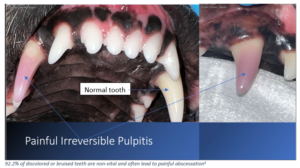
Extraction is a viable option, however, it is much more invasive, has a longer recovery time than root canal therapy, and can lead to dysfunction. For example, if a strategically important chewing tooth is extracted, then that dog will not chew kibble on the extracted side, shifting all chewing to the non-extracted side.
The non-chewing side tends to suffer much more periodontal disease because of the lack of the cleansing action of chewing. The non-extraction side experiences more wear because it is doing the bulk of chewing. If a dog has significant disease of the supporting structures (periodontal disease) then root canal therapy is not a good option and it most often must be extracted.
What is the Process of Root Canal Therapy?
Root canal therapy has basically four steps:
- Cleaning and shaping of the root/pulp canal
- Sterilization of the canal
- Fill (obturation) of the canal
- Placing a restoration (filling) at the access and/or fracture site

Small metal files progressing to larger files are used to clean and shape the canals by pushing them in and out.
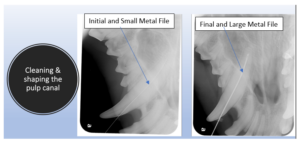
The tooth below is a maxillary (upper) fourth premolar. It is a strategically important chewing tooth. Note that it has three roots, therefore three root canal therapies are done.
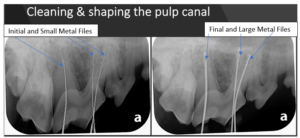
A needle is used to introduce disinfectants into the root/pulp canal.
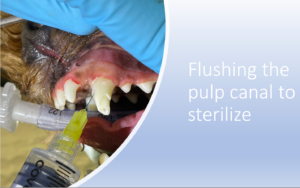
A substance referred to as gutta-percha is placed in the cleaned, shaped, and sterilized canals to seal them. All products used in veterinary root canal therapy are the same materials used on humans.

Composite is placed into the access site and fracture (left) and then light cured (right). This is the same material to fill teeth cavities in humans’ teeth.
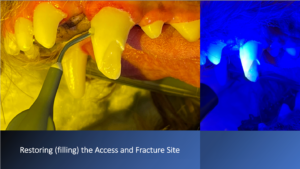
Most fractured teeth need a crown or cap. The proper term is full veneer metal restoration; however, the term is frequently shortened to “crown” or sometimes “cap”. For the purposes of this article, the term “crown” will be used in lieu of full veneer metal restoration.

Crown restoration would make the tooth stronger than the original tooth. They also protect the root canal therapy making a successful treatment even more successful. They also look way cool.
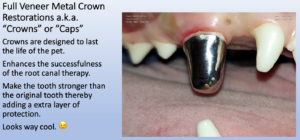
White porcelain is not used for crowns in veterinary dentistry because it is not strong enough to withstand the biting force of animals. A metal referred to as Tilite is the most commonly used. Tilite is an alloy of seven medically pure metals. It has been used in humans for decades. It has proven to be safe and very effective.

After root canal therapy the tooth is prepared for a crown. Then impressions (molds) are made of the teeth. The impressions are sent to the lab where the metal crown is fabricated. It takes the lab a week or two fabricate the crowns. When the crowns are received the doggie is scheduled to come have an additional short anesthetic procedure to cement the crown onto the tooth.
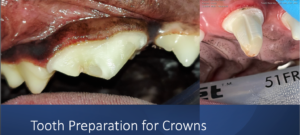
These two teeth have had root canal therapy and are ready for impressions.

The impressions are sent to the lab so that the crown(s) can be fabricated.

The finished product as received from the lab.
Dog Root Canal Therapy in Phoenix
If you are looking for a veterinary dentist who offers root canal therapy for dogs, look no further than our clinic. Our experienced veterinary dentists are board certified and use the latest technology and techniques to provide safe, effective, and compassionate care for your furry friend.
Don’t wait until your dog is in pain or their dental problems become more severe. Take action now and schedule an appointment with our veterinary dentist. We offer a range of dental services for dogs, including root canal therapy, to help keep your dog healthy, happy, and smiling. Contact us today to learn more and schedule your dog’s appointment.
References
(1) Da Bin Lee, Boaz Arzi, Philip H Kass, Frank J M Verstraete; Radiographic outcome of root canal treatment in dogs: 281 teeth in 204 dogs (2001-2018); J Am Vet Med Assoc.. 2022 Jan 4;260(5):535-542.
(2) F A Hale, J Vet Dent 2001 Mar;18(1):14-20
Photo by Justin Veenema on Unsplash
